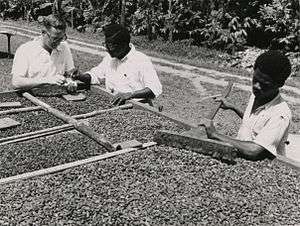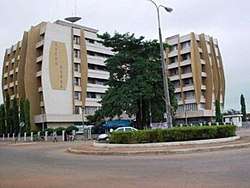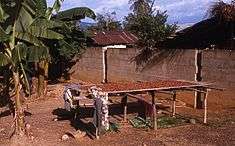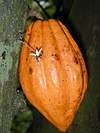Cocoa production in Ghana
Cocoa is the chief agricultural export of Ghana and Ghana's main cash crop.[1] Behind Ivory Coast, Ghana is the second largest cocoa exporter in the world.[2] Cocoa cultivation is not native to the country;[3] Ghana's cocoa cultivation, however, is noted within the developing world to be one of the most modeled commodities and valuables.[4]

Cocoa production occurs in the country's forested areas: Ashanti, Brong-Ahafo, Central Region, Eastern Region, Western Region, and Volta, where rainfall is 1,000-1,500 millimeters per year [5] [6]. The crop year begins in October, when purchases of the main crop begin, with a smaller mid-crop cycle beginning in July.[7]
All cocoa, except that which is smuggled out of the country, is sold at fixed prices to the Cocoa Marketing Board [8]. Although most cocoa production is carried out by peasant farmers on plots of less than three hectares, a small number of farmers appear to dominate the trade. Some studies show that about one-fourth of all cocoa farmers receive just over half of total cocoa income.[7]
With some two million children involved in the farming of cocoa in West Africa, primarily Ghana and Ivory Coast, child slavery and trafficking were major concerns in 2018.[9][10] However, international attempts to improve conditions for children were failing because of persistent poverty, absence of schools, increasing world cocoa demand, more intensive farming of cocoa, and continued exploitation of child labor.[9][11]
History
In 1979 the government initiated reform of the cocoa sector, focusing on the government's role in controlling the industry through the Cocoa Marketing Board. The board was dissolved and reconstituted as the Ghana Cocoa Board (Cocobod) [12] [13].
The government shifted responsibility for crop transport to the private sector. Subsidies for production inputs (fertilizers, insecticides, fungicides, and equipment) were removed, and there was a measure of privatization of the processing sector through at least one joint venture [14]. A new payment system known as the Akuafo Check System was introduced in 1982 at the point of purchase of dried beans. Formerly, produce buying clerks had often held back cash payments, abused funds, and paid farmers with false checks. Under the Akuafo system, a farmer was given a check signed by the produce clerk and the treasurer that he could cash at a bank of his choice [15] [16].
Plantation divestiture proceeded slowly, with only seven of fifty-two plantations sold by the end of 1990. Although Ghana was the world's largest cocoa producer in the early 1960s, by the early 1980s production had dwindled almost to the point of insignificance. The drop from an average of more than 450,000 tons per year to a low of 159,000 tons in 1983-84 has been attributed to aging trees, widespread disease, bad weather, and low producer prices [17]. In addition, bush fires in 1983 destroyed some 60,000 hectares of cocoa farms, so that the 1983-84 crop was barely 28 percent of the 557,000 tons recorded in 1964-65. Output then recovered to 228,000 tons in 1986-87. Revised figures show that production amounted to 301,000 tons in 1988-89, 293,000 tons in 1990-91, and 305,000 tons in 1992-93. After declining to 255,000 tons in 1993-94, the crop was projected to return to the 300,000 ton range in 1994-95.[7]
In the early 1990s, Cocobod continued to liberalize and to privatize cocoa marketing. The board raised prices to producers and introduced a new system providing greater incentives for private traders. In particular, Cocobod agreed to pay traders a minimum producer price as well as an additional fee to cover the buyers' operating and transportation costs and to provide some profit. Cocobod still handled overseas shipment and export of cocoa to ensure quality control.[7] [18]
In addition to instituting marketing reforms, the government also attempted to restructure cocoa production. In 1983 farmers were provided with seedlings to replace trees lost in the drought and trees more than thirty years old (about one-fourth of the total number of trees in 1984). Until the early 1990s, an estimated 40 hectares continued to be added to the total area of 800,000 hectares under cocoa production each year [19]. In addition, a major program to upgrade existing roads and to construct 3,000 kilometers of new feeder roads was launched to ease the transportation and sale of cocoa from some of the more neglected but very fertile growing areas on the border with Ivory Coast [20]. Furthermore, the government tried to increase Ghana's productivity from 300 kilograms per hectare to compete with Southeast Asian productivity of almost 1,000 kilograms per hectare. New emphasis was placed on extension services, drought and disease research, and the use of fertilizers and insecticides. The results of these measures were to be seen in rising cocoa production from the 1990s to the present.[7]
Recent Growth
Ghana's cocoa production grew an average of 16% between 2000–03.[21] Cocoa has a long production cycle, far longer than many other tropical crops, and new hybrid varieties need over five years to come into production, and a further 10 to 15 years for the tree to reach its full bearing potential. The reasons for this huge production increase are varied and in fact Ghana's cocoa yields per hectare are still low by international standards.[21] Researchers at the Overseas Development Institute identify the following as particularly important:[21]
- Land
- Labour
- Fertiliser
- Insecticide
- Agricultural equipment
- Western Sefwi (suggesting smuggling from processing Ivory Coast)
- Rainfall
- Cocoa farmer
- Use of spraying machine
This study also suggests that the most important factors in the increased proan are:[21]
- New land brought under cultivation
- More intensive use of household labour
- A good rainfall pattern
- Effectiveness of farm spraying and increased fertilizer use
This study suggests that Ghana's cocoa farmers are not making the best use of technological innovations in their production and instead their increased production is not sustainable.[21] Bringing new land under cultivation is risky, as much of the land was previously forest and after a short period and without adequate attention this land may be exhausted. Intensive use of labour has led to high increases in the cost of labour and may impact profitability, and high rainfall is only periodic.[21] Cocoa serves as a major source of living for most people in Ghana. In the rural areas, most adults are farmers and have plantation farms which provide them with an income. Inrecent years, the production of Cocoa in Ghana has increased tremendously due to the fact that, the government has provided the agricultural industry in Ghana with incentives which has boosted the interest of young adults to expand their farms and plant more cocoa. The world market have increased the prices of cocoa so it has served as a major source of revenue for the people in Ghana who cultivate cocoa.
Hybrid System of Liberalization

Ghana Cocoa Board's experimentation with privatization has created a hybrid system whereby despite all exports being controlled by the state, there are now around 25 private companies buying the crop in all areas of the country where it is grown.[22] After 14 years, the successes and failures of this hybrid system have been the subject of a study by researchers at the Overseas Development Institute. Competition was clearly found to have increased production levels throughout the country, yet access to credit remained one of the most important factors determining the level of competition. Farmers rarely made the most of all the available options to sell their crop (often they only made use of one).[22]
Their choice was based on the ability of a company to pay promptly in cash and thus there were only five major players on the market: PBC (formerly state-owned), Kuapa Kokoo (a hugely successful farmers-based cooperative working on fair trade principle), Adwumapa (a Ghanaian buying company), Olam and Armajaro (both foreign-owned companies, from Singapore and the UK respectively).[22] Another key determining factor is the distance of the plantation from the main market, as more remote farms more often found it easier to sell to the formerly state-owned PBC.[22]
This hybrid scheme benefits a variety of players:[22]
- The state, which maintains a monopoly on all exports and makes a substantially higher return from taxation than other cocoa regions;
- The traders, who compete for the purchase of higher volumes of the export crop on non-price terms throughout the cocoa belt areas; and
- The farmers, who are guaranteed a minimum floor price regardless of their geographical location.
Researchers at the ODI therefore suggest that liberalization has been good for producers by:[22]
- providing farmers with more choice of buyers;
- delivering cash payments promptly; and
- maintaining stability in producer prices throughout the season.
Yet the question remains for policy-makers as to the benefits of the state controlling an export monopoly and its strong presence of the public sector in the internal market, whether there should be even more liberalization, and whether it is providing the right incentives for producers to develop better (and sustainable) farming practices.[22]
Child Labour
A major study of the issue in 2016, published in Fortune Magazine in the U.S., concluded that approximately 2.1 million children in various countries of West Africa "still do the dangerous and physically taxing work of harvesting cocoa". The report was doubtful as to whether the situation can be improved.
The article provided this comment. "According to the 2015 edition of the Cocoa Barometer, a biennial report examining the economics of cocoa that’s published by a consortium of nonprofits, the average farmer in Ghana in the 2013–14 growing season made just 84¢ per day, and farmers in Ivory Coast a mere 50¢. That puts them well below the World Bank’s new $1.90 per day standard for extreme poverty, even if you factor in the 13% rise in the price of cocoa last year. And in that context the challenge of eradicating child labor feels immense, and the chocolate companies’ newfound commitment to expanding the investments in cocoa communities not quite sufficient. ... 'Best-case scenario, we’re only doing 10% of what’s needed.' Getting that other 90% won’t be easy. 'It’s such a colossal issue,' says Sona Ebai, the former secretary general of the Alliance of Cocoa Producing Countries. 'I think child labor cannot be just the responsibility of industry to solve. I think it’s the proverbial all-hands-on-deck: government, civil society, the private sector.'He pauses, taking in his own thought for a moment. 'And there, you really need leadership.'"[23]
In April 2018, the Cocoa Barometer 2018 report on the $100-billion industry, said this about the child labor situation: "Not a single company or government is anywhere near reaching the sector-wide objective of the elimination of child labour, and not even near their commitments of a 70% reduction of child labour by 2020". A report later that year by New Food Economy stated that the Child Labour Monitoring and Remediation Systems implemented by the International Cocoa Initiative and its partners has been useful, but "they are currently reaching less than 20 percent of the over two million children impacted".[24]
See also
References
- "Supply Chain Risk Assessment: Cocoa in Ghana". Forum for Agricultural Risk Management in Development. Archived from the original on 25 September 2013. Retrieved 21 September 2013.
- "UPDATE 1-Ghana signs $1.2 bln cocoa loan for 2013/14 crop purchases". Reuters. September 20, 2013. Retrieved 21 September 2013.
- Salm & Falola 2002, p. 15.
- Bulir 1998, p. 4.
- Ago, Jerryfreshmanin #entrepreneurship • 2 Years (2018-05-14). "GHANA COCOA GOLDEN AGRICULTURE". Hive. Retrieved 2020-05-25.
- "Ghana - Cocoa". countrystudies.us. Retrieved 2020-05-25.
- Clark, Nancy L. "Agriculture" (and subchapters). A Country Study: Ghana (La Verle Berry, editor). Library of Congress Federal Research Division (November 1994). This article incorporates text from this source, which is in the public domain.
- "Our World - Ghana". www.unitedworld-usa.com. Retrieved 2020-05-25.
- Emiko Terazono (18 April 2018). "Chocolate industry accused of failure on child labour". The Financial Times. Retrieved 8 January 2019.
- Kieran Guilbert (12 June 2017). "Falling cocoa prices threaten child labor spike in Ghana, Ivory Coast". Reuters. Retrieved 7 January 2019.
- Oliver Balch (20 June 2018). "Child labour: the true cost of chocolate production". Raconteur. Retrieved 7 January 2019.
- "Trace the history of cocoa cultivation till its cultivation on commercial level in Ghana - Brainly.in". brainly.in. Retrieved 2020-05-25.
- "Our World - Ghana". www.unitedworld-usa.com. Retrieved 2020-05-25.
- "Ghana Economy". www.modernghana.com. Retrieved 2020-05-25.
- Agyepong, Stephen (February 2018). "Thesis". S2CID 159201535. Cite journal requires
|journal=(help) - Owusu, Sebastian Kwakwu (July 2013). "Identification of the critical points for polycyclic aromatic hydrocarbon contamination along the cocoa processing and storage chain in Ghana" (PDF). KNUST IR. Retrieved 25 May 2020.
- Mulangu, Francis (August 2015). "Thesis" (PDF). AGRODEP Working Paper. Retrieved 25 May 2020.
- Amedofu, Mawuli (October 2009). "Determination of cocoa producer price in Ghana: an empirical investigation" (PDF). KNUST IR. Retrieved 25 May 2020.
- "Ghana - Cocoa". countrystudies.us. Retrieved 2020-05-26.
- Mortimer, Louis R. (1995) [1971]. Ghana: a country study (PDF). Memory.loc.gov. US: Headquarters Department of the Army. ISBN 0-8444-0835-2. Retrieved 25 May 2020.
- Marcella Vigneri 2007 Drivers of cocoa production growth in Ghana Overseas Development Institute
- Marcella Vigneri and Paulo Santos 2007 Ghana and the cocoa marketing dilemma: What has liberalisation without price competition achieved? Overseas Development Institute
- O'Keefe, Brian (1 March 2016). "Behind a bittersweet industry". Fortune.com. Fortune. Retrieved 7 January 2018.
For a decade and a half, the big chocolate makers have promised to end child labor in their industry—and have spent tens of millions of dollars in the effort. But as of the latest estimate, 2.1 million West African children still do the dangerous and physically taxing work of harvesting cocoa. What will it take to fix the problem
- "Cocoa has a poverty problem. You can help by eating more dark chocolate". New Food Economy. 7 July 2018. Retrieved 7 July 2018.
In 2001, companies including Mars, Ferrero, the Hershey Company, Kraft Foods, and Nestlé expressed their collective commitment to combat child labor in cocoa growing communities in West Africa through their support of the Harkin-Engel Protocol, an international agreement aimed at reducing the worst forms of child labor in the cocoa sector in Ivory Coast and Ghana by 70 percent by 2020.
- Bibliography
- Bulir, Ales (1 June 1998). The Price Incentive to Smuggle and the Cocoa Supply in Ghana, 1950-96. International Monetary Fund. ISBN 978-1-4518-9707-4.CS1 maint: ref=harv (link)
- Salm, Steven J.; Falola, Toyin (1 January 2002). Culture and Customs of Ghana. Greenwood Publishing Group. p. 15. ISBN 978-0-313-32050-7.CS1 maint: ref=harv (link)

